Numerical Investigation of Mineral Grain Shape Effects on Strength and Fracture Behaviors of Rock Material
Abstract
:1. Introduction
2. Modeling Methodology
3. Model Descriptions
3.1. Construction of Mineral Grains of Different Shapes
- The strip-shaped grain was composed of two circular particles of the same radius R. The six grains in this group were represented as S1–S6. From S1 to S6, the distance d between the centers of the two circular particles gradually increased, and the ratios of d to R were 0, 0.25, 0.5, 1.0, 1.25, and 1.5, respectively.
- The triangular grain was composed of three circular particles of the same radius R. The line connecting the centers of the three circular particles was an equilateral triangle with a side length of d. The six grains in this group were represented as T1–T6. From T1 to T6, the value of d was gradually increased. The variation of d/R was consistent with the strip-shaped grains.
- The square grain was composed of four circular particles of the same radius R. The line connecting the centers of the four circular particles was a square with a side length of d. The six grains in this group were represented as R1–R6. From R1 to R6, the value of d was gradually increased. The variation of d/R was also consistent with the strip-shaped grains.
3.2. Quantitative Description of Grain Shape
3.3. Calibration of the Microparameters
4. Analysis of Grain Shape Effects
4.1. Effects of Grain Shape on Rock Macroscopic Parameters
4.2. Effects of Grain Shape on Rock Failure Mode
5. Conclusions
- The elastic modulus and peak strength of rock are affected by the mineral grain shape. In our study, the model with strip-shaped grains had the largest elastic modulus and peak strength, followed by the triangular grain and square grain models. The mechanism of grain shape effect on the peak strength and elastic modulus was mainly achieved by affecting the porosity of the model. The increasing porosity led to a smaller peak strength and elastic modulus.
- Flatness and roughness can describe the overall contour and surface morphology of mineral grains well. The effects of grain flatness and surface roughness on rock peak strength are the opposite. A flat grain helps to increase rock strength, while rock strength is reduced due to increased porosity if the grain has higher roughness. Further, the relationship between the peak strength and the cohesion of rock is positively correlated.
- Here, the generated microcracks were mainly of the tension type, and the model with square grains had the maximum ratio of tensile cracking, followed by the triangular grain and strip-shaped grain models. The shape of the mineral grain also had a significant effect on rock mechanical behaviors at the postpeak stage. The stress drop became slower with an increasing surface roughness because the interlocking restrained the slip and rotation of grains on the fracture surface.
Author Contributions
Funding
Conflicts of Interest
References
- Han, Z.H.; Zhou, J.; Zhang, L.Q. Influence of Grain Size Heterogeneity and In-Situ Stress on the Hydraulic Fracturing Process by PFC 2D Modeling. Energies 2018, 11, 1413. [Google Scholar] [CrossRef]
- Lajtai, E.Z. Brittle fracture in compression. Int. J. Fra. 1974, 10, 525–536. [Google Scholar] [CrossRef]
- Nicksiar, M.; Martin, C.D. Evaluation of Methods for Determining Crack Initiation in Compression Tests on Low-Porosity Rocks. Rock Mech. Rock Eng. 2012, 45, 607–617. [Google Scholar] [CrossRef]
- Basu, A.; Mishra, D.A.; Roychowdhury, K. Rock failure modes under uniaxial compression, Brazilian, and point load tests. Bull. Eng. Geol. Environ. 2013, 72, 457–475. [Google Scholar] [CrossRef]
- Koyama, T.; Jing, L. Effects of model scale and particle size on micro-mechanical properties and failure processes of rocks-A particle mechanics approach. En. Anal. Bound. Elem. 2007, 31, 458–472. [Google Scholar] [CrossRef]
- Hosseininia, E.S. Erratum to: Investigating the micromechanical evolutions within inherently anisotropic granular materials using discrete element method. Granular Matter. 2012, 14, 483–503. [Google Scholar] [CrossRef]
- Rong, G.; Liu, G.; Hou, D.; Zhou, C.B. Effect of Particle Shape on Mechanical Behaviors of Rocks: A Numerical Study Using Clumped Particle Model. Sci. World J. 2013, 2013, 589215. [Google Scholar] [CrossRef]
- Wiącek, J.; Molenda, M.; Horabik, J.; Ooi, J.Y. Influence of grain shape and intergranular friction on material behavior in uniaxial compression: Experimental and DEM modeling. Powder Technol. 2012, 217, 435–442. [Google Scholar] [CrossRef]
- Lan, H.X.; Martin, C.D.; Hu, B. Effect of heterogeneity of brittle rock on micromechanical extensile behavior during compression loading. J. Geophys. Res-Sol. Ea. 2010, 115, 414–431. [Google Scholar] [CrossRef]
- Manouchehrian, A.; Cai, M. Influence of material heterogeneity on failure intensity in unstable rock failure. Comput. Geotech. 2016, 71, 237–246. [Google Scholar] [CrossRef]
- Peng, J.; Wong, L.N.Y.; The, C.I. Influence of grain size heterogeneity on strength and microcracking behavior of crystalline rocks. J. Geophys. Res-Sol. Ea. 2017, 122, 1054–1073. [Google Scholar] [CrossRef] [Green Version]
- Shinohara, K.; Oida, M.; Golman, B. Effect of particle shape on angle of internal friction by triaxial compression test. Powder Technol. 2000, 107, 131–136. [Google Scholar] [CrossRef]
- Härtl, J.; Jin, Y.O. Numerical investigation of particle shape and particle friction on limiting bulk friction in direct shear tests and comparison with experiments. Powder Technol. 2011, 212, 231–239. [Google Scholar] [CrossRef]
- Liu, Q.B.; Xiang, W.; Budhu, M.; Cui, D.-S. Study of particle shape quantification and effect on mechanical property of sand. Rock Soil Mech. 2011, 32, 190–197. [Google Scholar]
- Johanson, K. Effect of particle shape on unconfined yield strength. Powder Technol. 2009, 194, 246–251. [Google Scholar] [CrossRef]
- Cundall, P.A. A computer model for simulating progressive, large-scale movements in blocky rock systems. Proc. Int. symp. on Rock Fracture 1971, 2, 2–8. [Google Scholar]
- Potyondy, D.O.; Cundall, P.A. A Bonded-Particle Model for Rock. Int. J. Rock Mech. Min. 2004, 41, 1329–1364. [Google Scholar] [CrossRef]
- Potyondy, D.O. The bonded-particle model as a tool for rock mechanics research and application: Current trends and future directions. Geo. Eng. 2015, 18, 1–28. [Google Scholar] [CrossRef]
- Zhou, J.; Lan, H.X.; Zhang, L.Q.; Yang, D.X.; Song, J.; Wang, S. Novel Grains Bonded Model for Simulation of Brittle Failure of Alxa Porphyritic Granite. Eng. Geo. 2019, 251, 100–114. [Google Scholar] [CrossRef]
- Zhou, J.; Zhang, L.Q.; Yang, D.X.; Braun, A.; Zhenhua, H. Investigation of the Quasi-Brittle Failure of Alashan Granite Viewed from Laboratory Experiments and Grain-Based Discrete Element Modeling. Materials 2017, 10, 835. [Google Scholar] [CrossRef]
- Cho, N.; Martin, C.D.; Sego, D.C. A clumped particle model for rock. Int. J. Rock Mech. Min. 2007, 44, 997–1010. [Google Scholar] [CrossRef]
- Santamarina, J.C.; Cho, G.C. Soil behaviour: The role of particle shape. In Proceedings of the Skempton Conference, London, UK, 29–31 March 2004. [Google Scholar]
- Shi, D.D.; Zhou, J.; Liu, W.B.; Jia, M.C. Numerical simulation for behaviors of sand with non-circular particles under monotonic shear loading. Chinese J. Geotech. Eng. 2008, 30, 1361–1366. [Google Scholar]
- Shi, D.D.; Zhou, J.; Liu, W.B.; Deng, Y.B. Exploring macro- and micro-scale responses of sand in direct shear tests by numerical simulations using non-circular particles. Chinese J. Geotech. Eng. 2010, 32, 1557–1565. [Google Scholar]
- Kong, L.; Peng, R. Particle flow simulation of influence of particle shape on mechanical properties of quasi-sands. Chinese J. Rock Mech. Eng. 2011, 30, 2112–2118. [Google Scholar]
- Kerimov, A.; Mavko, G.; Mukerji, T.; Dvorkin, J.; Al Ibrahim, M.A. The influence of convex particles irregular shape and varying size on porosity, permeability, and elastic bulk modulus of granular porous media: Insights from numerical simulations. J. Geophys. Res-Sol. Ea. 2018, 123, 10563–10582. [Google Scholar] [CrossRef]
- Kern, H.; Ivankina, T.I.; Nikitin, A.N.; Lokajicek, T.; Pros, Z. The effect of oriented microcracks and crystallographic and shape preferred orientation on bulk elastic anisotropy of a foliated biotite gneiss from Outokumpu. Tectonophysics. 2008, 457, 143–149. [Google Scholar] [CrossRef]
- Mark, L.H.; Neil, W.P. Selection of Descriptors for Particle Shape Characterization. Part. Part. Sys. Char. 2010, 20, 25–38. [Google Scholar]
- Mora, C.; Kwan, A. Sphericity, shape factor, and convexity measurement of coarse aggregate for concrete using digital image processing. Cement Concrete Res. 2000, 30, 351–358. [Google Scholar] [CrossRef]
- Hazzard, J.F.; Young, R.P.; Maxwell, S.C. Micromechanical modeling of cracking and failure in brittle rocks. J. Geophys. Res-Sol. Ea. 2000, 105, 16683–16697. [Google Scholar] [CrossRef]
- Weng, M.C.; Li, H.H. Relationship between the deformation characteristics and microscopic properties of sandstone explored by the bonded-particle model. Int. J. Rock Mech. Min. Sci. 2012, 56, 34–43. [Google Scholar] [CrossRef]
- Yoon, J. Application of experimental design and optimization to PFC model calibration in uniaxial compression simulation. Int. J. Rock Mech. Min. Sci. 2007, 44, 871–889. [Google Scholar] [CrossRef]
- Vernik, L.; Bruno, M.; Bovberg, C. Empirical relations between compressive strength and porosity of siliciclastic rocks. Int. J. Rock Mech. Min. 1993, 30, 677–680. [Google Scholar] [CrossRef]
- Palchik, V. Influence of porosity and elastic modulus on uniaxial compressive strength in soft brittle porous sandstones. Rock Mech. Rock Eng. 1999, 32, 303–309. [Google Scholar] [CrossRef]
- Bell, F.G.; Lindsay, P. The petrographic and geomechanical properties of some sandstones from the Newspaper Member of the Natal Group near Durban, South Africa. Eng. Geo. 1999, 53, 57–81. [Google Scholar] [CrossRef]
- Hudyma, N.; Avar, B.B.; Karakouzian, M. Compressive strength and failure modes of lithophysae-rich Topopah Spring Tuff specimens and analog models containing cavities. Eng. Geo. 2004, 73, 179–190. [Google Scholar] [CrossRef]
- Al-Harthi, A.A.; Al-Amri, R.M.; Shehata, W.M. The porosity and engineering properties of vesicular basalt in Saudi Arabia. Eng. Geo. 1999, 54, 313–320. [Google Scholar] [CrossRef]
- Schopfer, M.P.J.; Abe, S.; Childs, C.; Walsh, J.J. The impact of porosity and crack density on the elasticity, strength and friction of cohesive granular materials: Insights from DEM modelling. Int. J. Rock Mech. Min. 2009, 46, 250–261. [Google Scholar] [CrossRef]
- Zhang, Z.; Shu, G.P. Effect of particle shape on biaxial tests simulated by particle flow code. Chinese J. Geotech. Eng. 2009, 31, 1281–1286. [Google Scholar]
- Cho, G.C.; Dodds, J.; Santamarina, J.C. Particle Shape Effects on Packing Density, Stiffness, and Strength: Natural and Crushed Sands. J. Geotech. Geo. Eng. 2006, 133, 591–602. [Google Scholar] [CrossRef]
- Backers, T.; Stanchits, S.; Dresen, G. Tensile fracture propagation and acoustic emission activity in sandstone: The effect of loading rate. Int. J. Rock Mech. Min. 2005, 42, 1094–1101. [Google Scholar] [CrossRef]
- Brace, W.F.; Bombolakis, E.G. A note on brittle crack growth in compression. J. Geophys. Res. 1963, 68, 3709–3713. [Google Scholar] [CrossRef]
- Diederichs, M.S.; Kaiser, P.K.; Eberhardt, E. Damage initiation and propagation in hard rock during tunneling and the influence of near-face stress rotation. Int. J. Rock Mech. Min. 2004, 41, 785–812. [Google Scholar] [CrossRef]
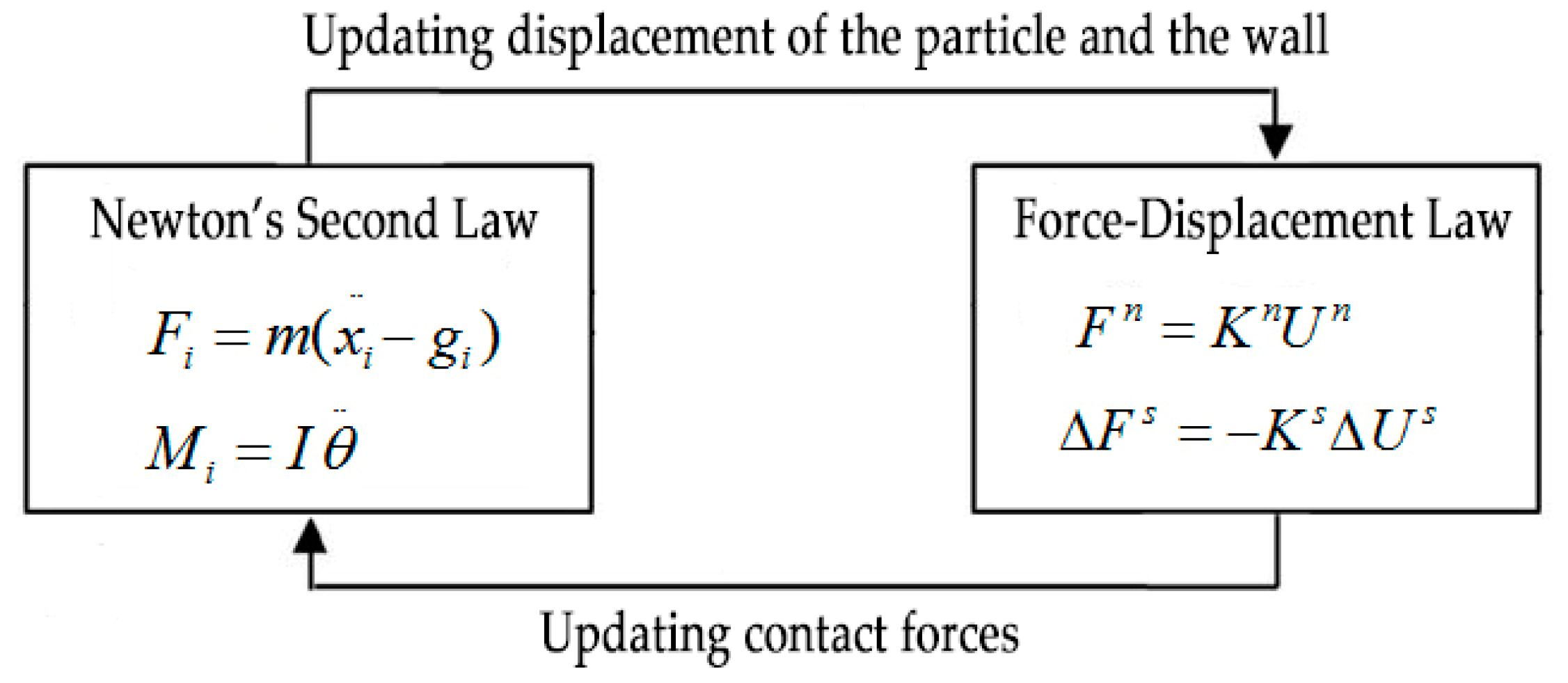

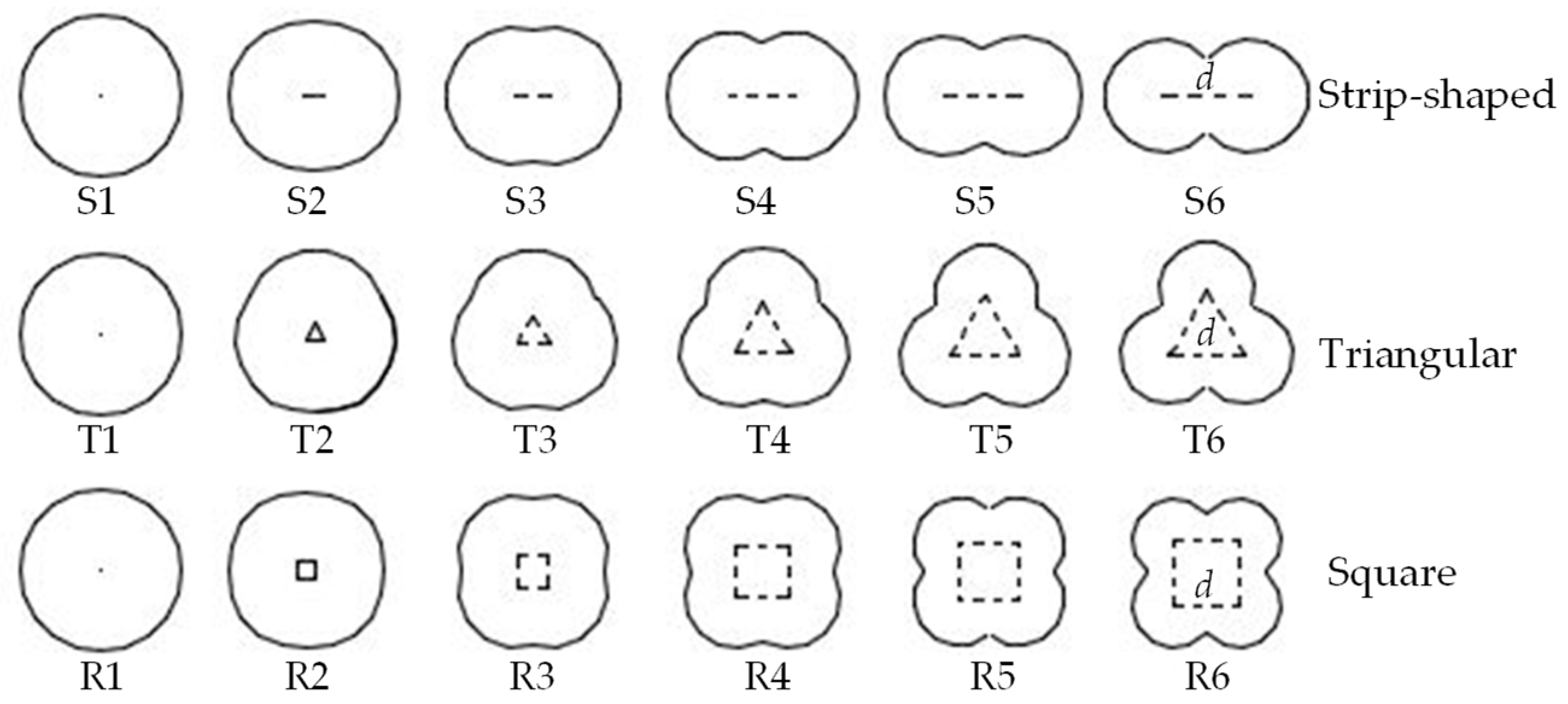
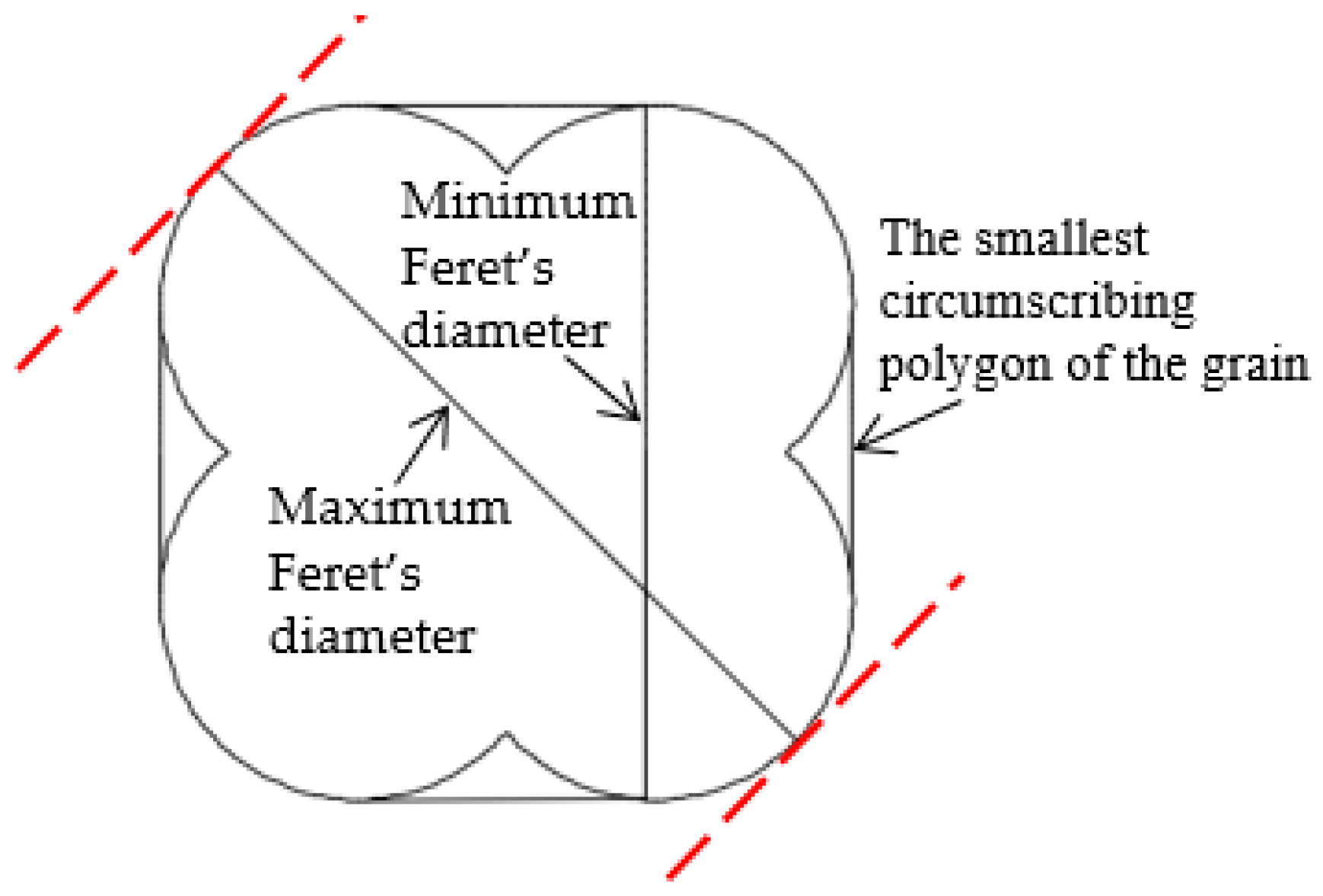

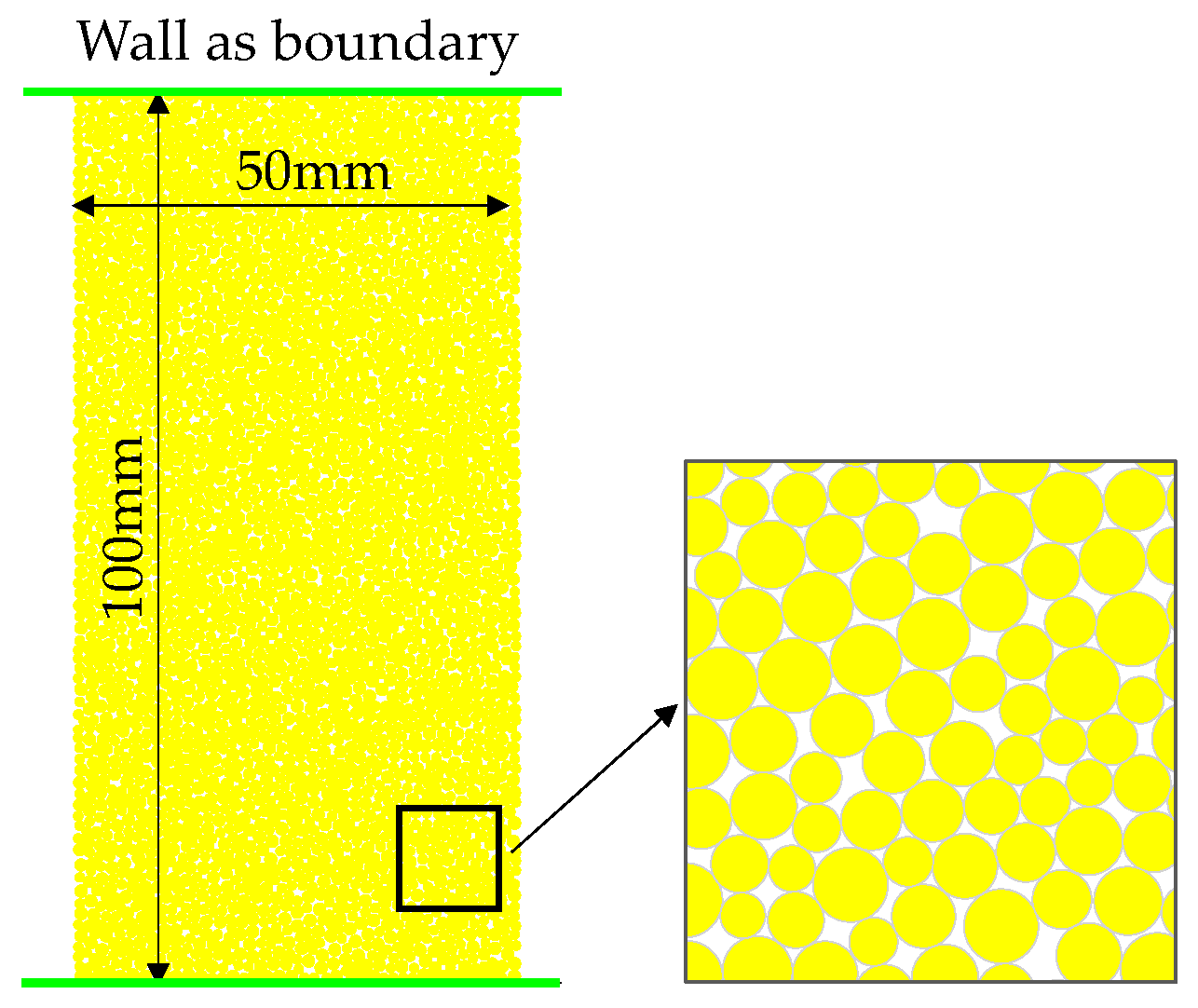
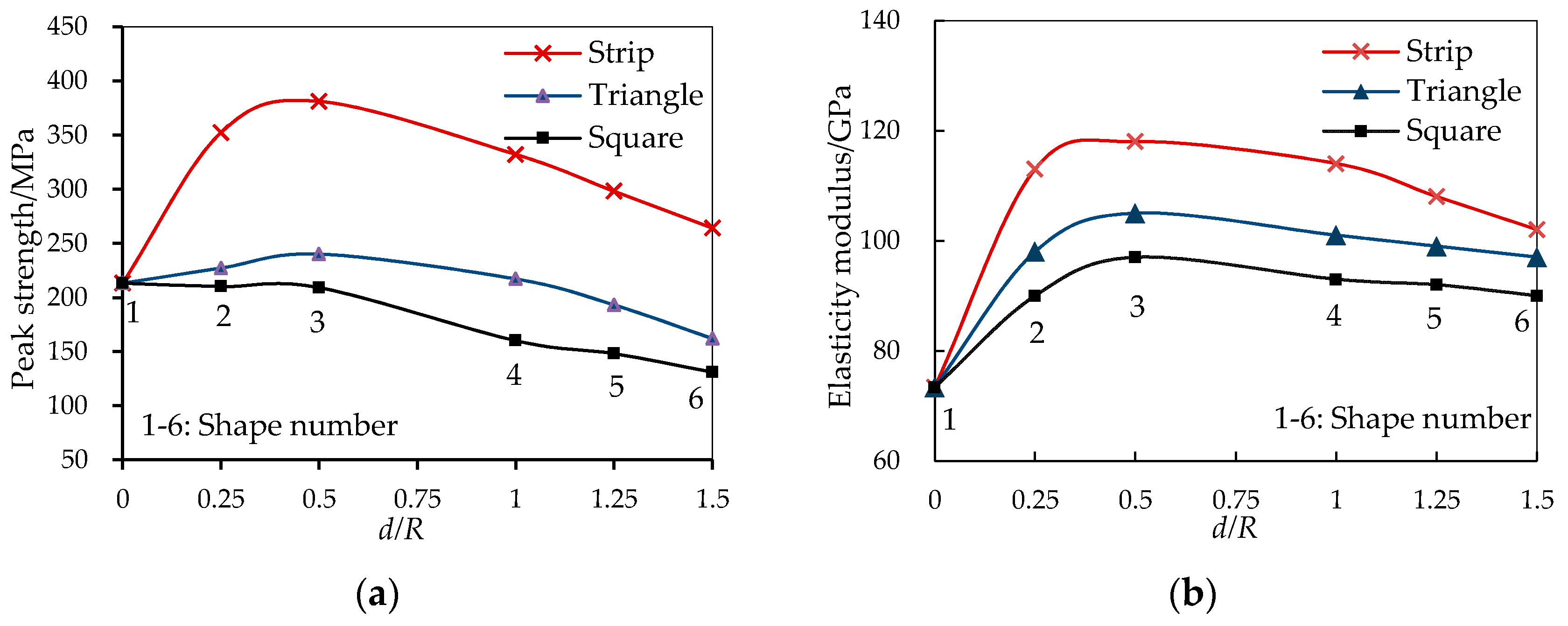
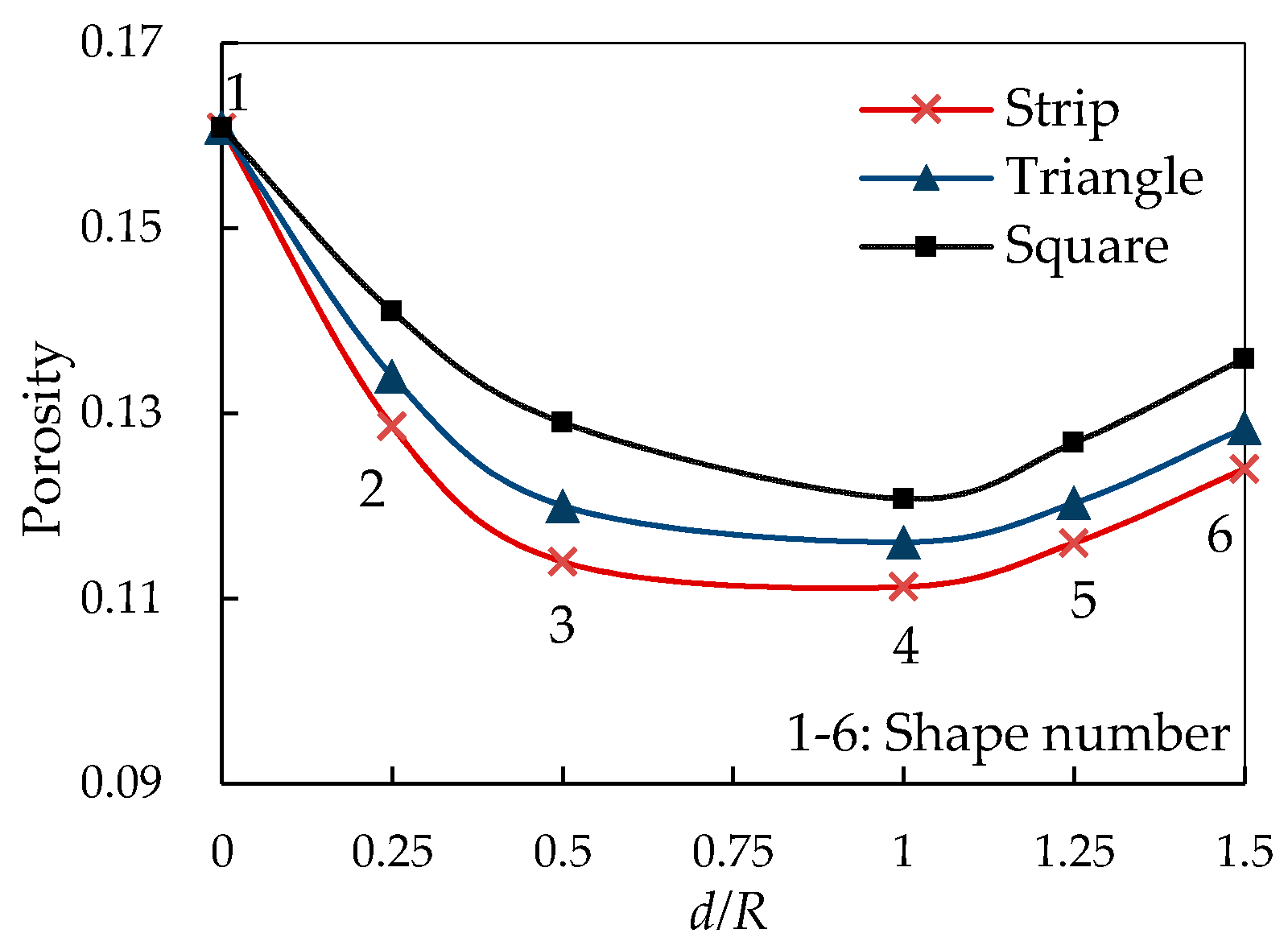
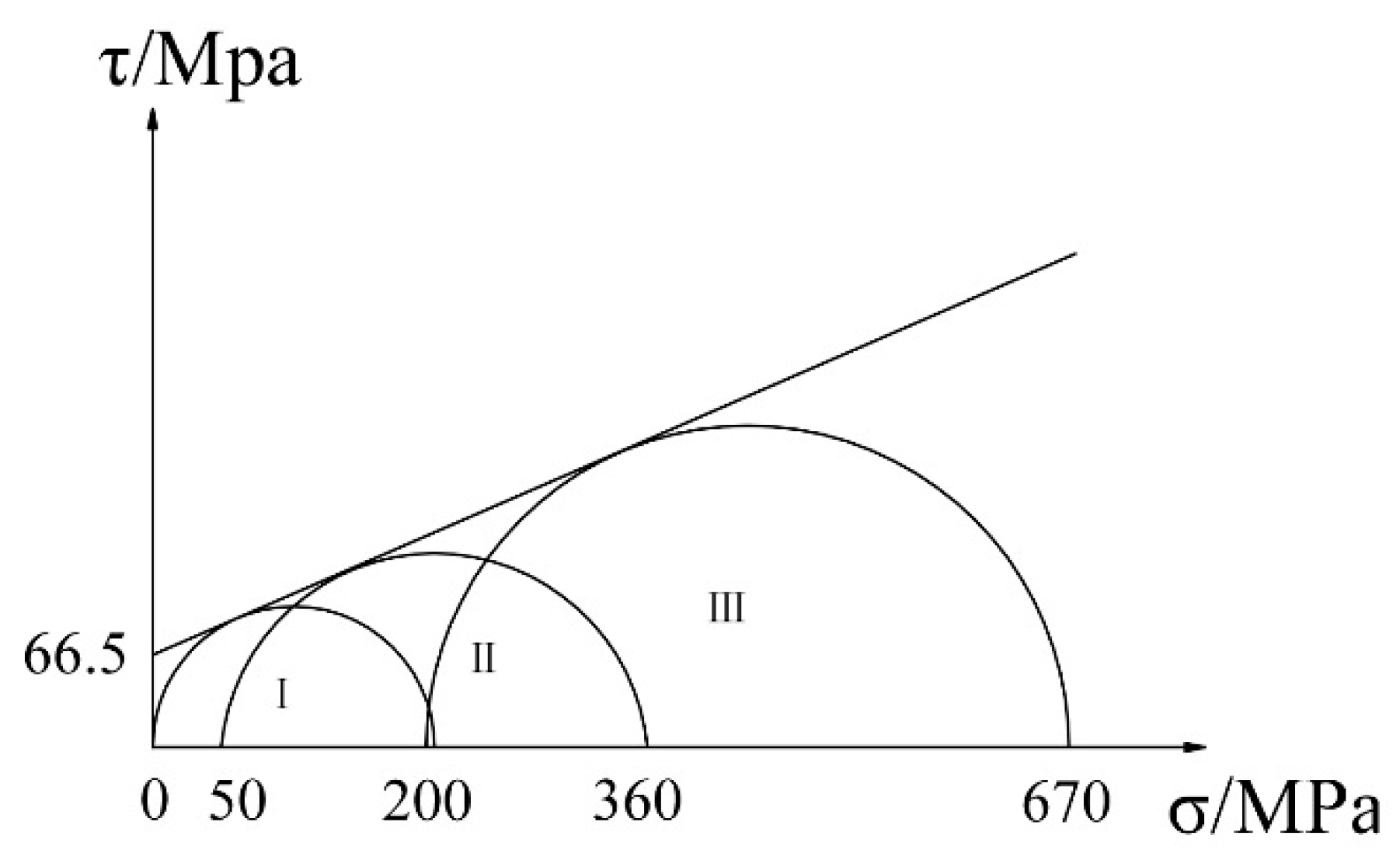
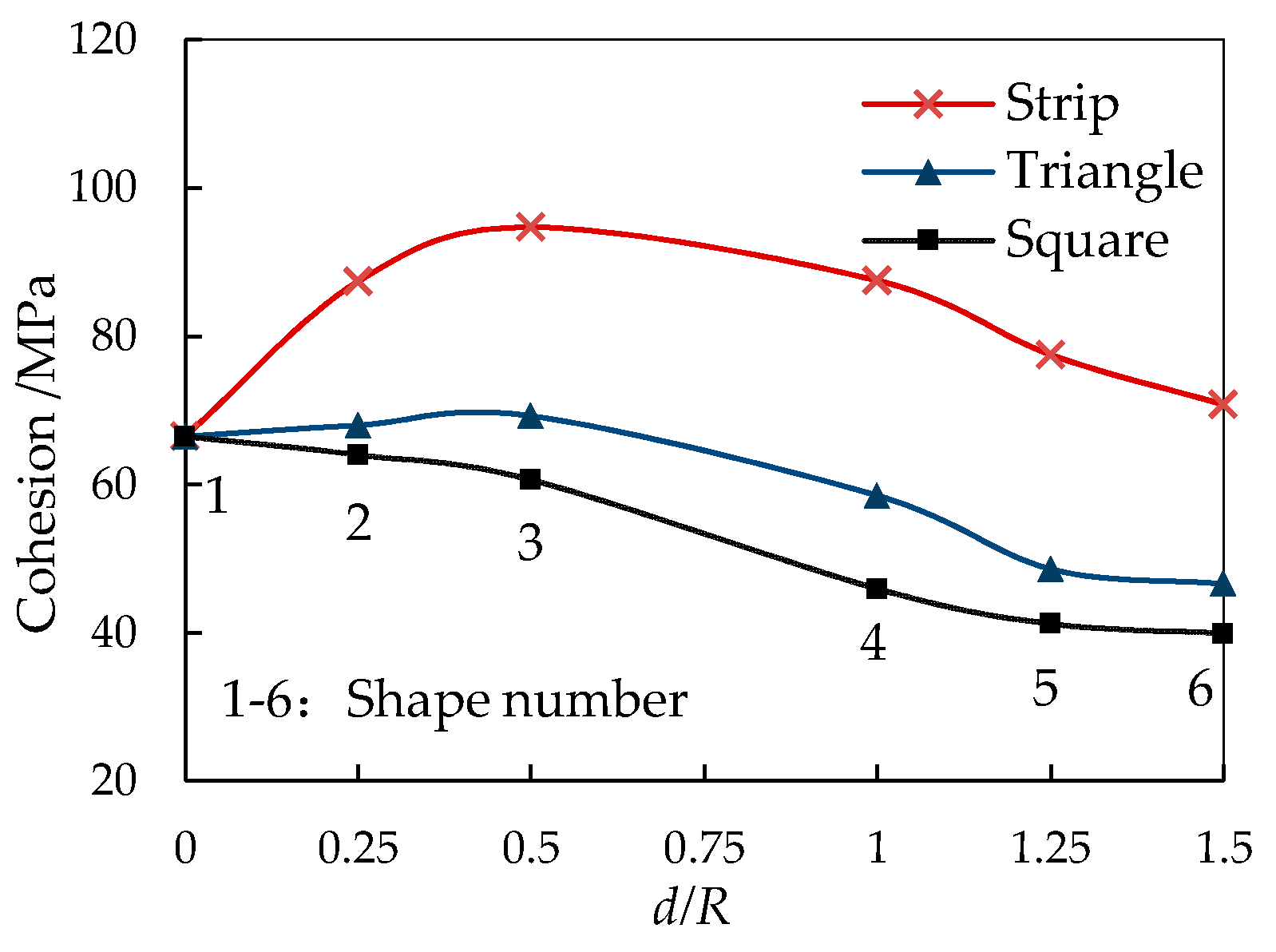
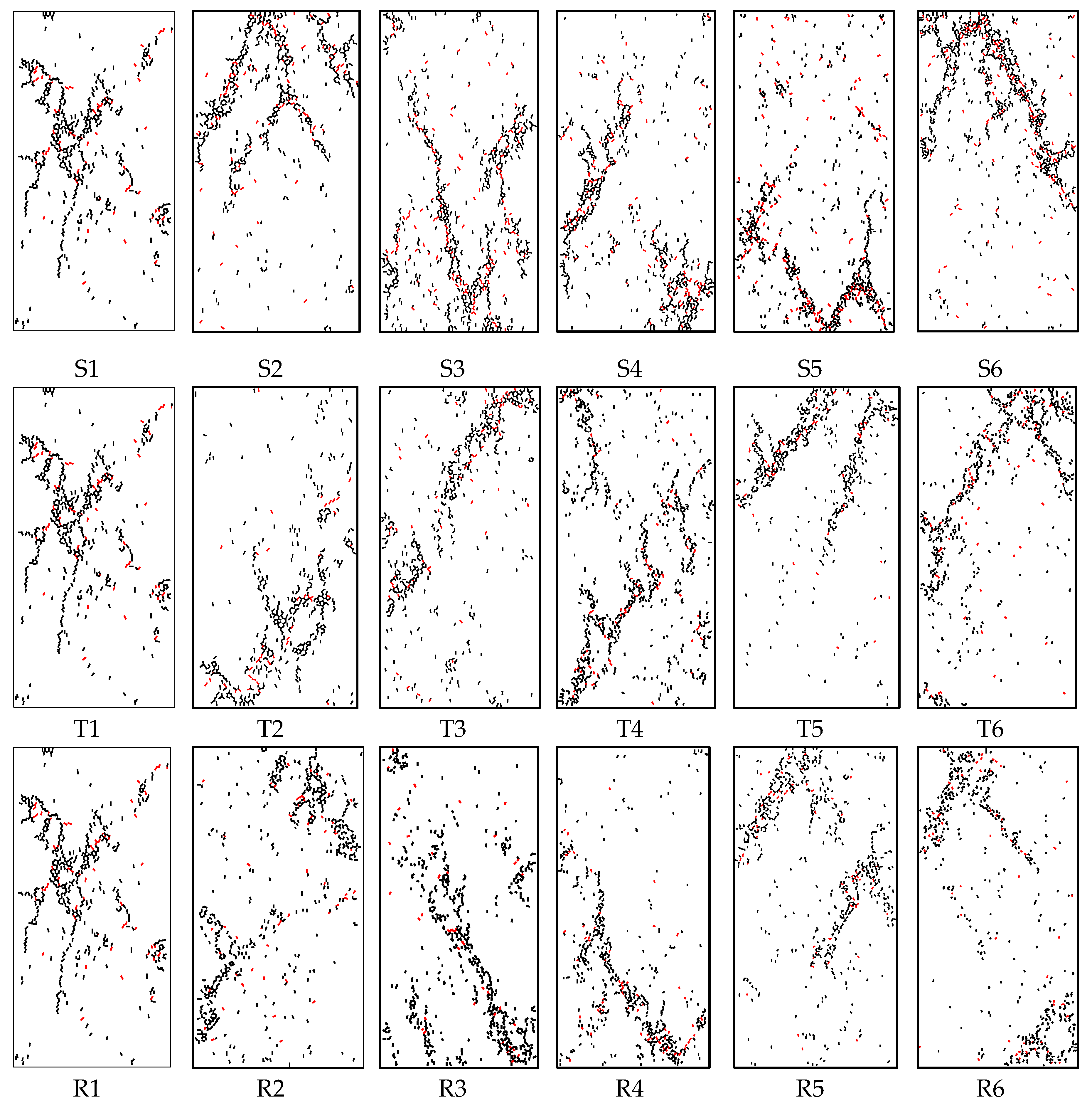

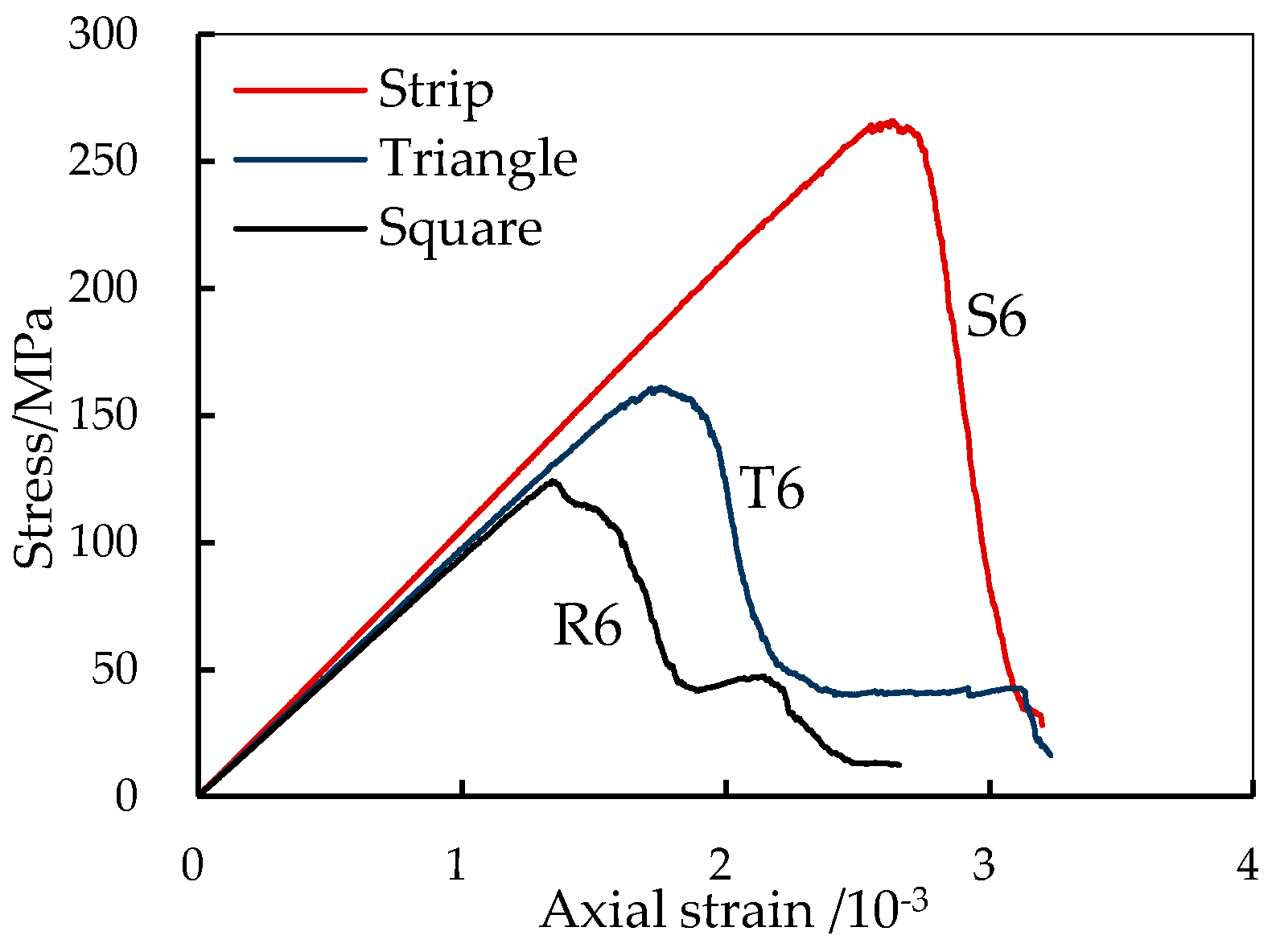
| Classification | Microparameters | Notations | Values |
|---|---|---|---|
| Particle | Density (kg/m3) | 2630 | |
| Contact modulus (GPa) | E | 62 | |
| Normal-to-shear stiffness ratio | kn/ks | 2.5 | |
| Friction coefficient | u | 0.5 | |
| Parallel bond between particles | Tensile strength (MPa) | σc | 157 |
| Standard deviation /MPa | σcs | 36 | |
| Normal-to-shear stiffness ratio | 2.5 | ||
| Shear strength (MPa) | τc | 175 | |
| Standard deviation /MPa | τcs | 40 | |
| Modulus (GPa) | Ec | 62 | |
| Radius multiplier | λ | 1 |
| Ratio of Tensile Crack (%) | Shape Number | |||||
|---|---|---|---|---|---|---|
| 1 | 2 | 3 | 4 | 5 | 6 | |
| Strip-shaped grain | 88 | 87 | 83 | 85 | 79 | 83 |
| Triangular grain | 88 | 92 | 90 | 92 | 92 | 90 |
| Square grain | 88 | 92 | 95 | 93 | 93 | 91 |
© 2019 by the authors. Licensee MDPI, Basel, Switzerland. This article is an open access article distributed under the terms and conditions of the Creative Commons Attribution (CC BY) license (http://creativecommons.org/licenses/by/4.0/).
Share and Cite
Han, Z.; Zhang, L.; Zhou, J. Numerical Investigation of Mineral Grain Shape Effects on Strength and Fracture Behaviors of Rock Material. Appl. Sci. 2019, 9, 2855. https://doi.org/10.3390/app9142855
Han Z, Zhang L, Zhou J. Numerical Investigation of Mineral Grain Shape Effects on Strength and Fracture Behaviors of Rock Material. Applied Sciences. 2019; 9(14):2855. https://doi.org/10.3390/app9142855
Chicago/Turabian StyleHan, Zhenhua, Luqing Zhang, and Jian Zhou. 2019. "Numerical Investigation of Mineral Grain Shape Effects on Strength and Fracture Behaviors of Rock Material" Applied Sciences 9, no. 14: 2855. https://doi.org/10.3390/app9142855





